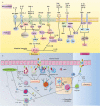The mycobiota of the human body: a spark can start a prairie fire
- PMID: 32150513
- PMCID: PMC7524315
- DOI: 10.1080/19490976.2020.1731287
The mycobiota of the human body: a spark can start a prairie fire
Abstract
Mycobiota are inseparable from human health, shaking up the unique position held by bacteria among microorganisms. What is surprising is that this seemingly small species can trigger huge changes in the human body. Dysbiosis and invasion of mycobiota are confirmed to cause disease in different parts of the body. Meanwhile, our body also produces corresponding immune changes upon mycobiota infection. Several recent studies have made a connection between intestinal mycobiota and the human immune system. In this review, we focus on questions related to mycobiota, starting with an introduction of select species, then we summarize the typical diseases caused by mycobiota in different parts of the human body. Moreover, we constructed a framework for the human anti-fungal immune system based on genetics and immunology. Finally, the progression of fungal detection methods is also reviewed.
Keywords: Mycobiota; colorectal carcinogenesis; detection methods; host-microbe interaction; immunity.
Figures





Similar articles
-
Mycobiota in gastrointestinal diseases.Nat Rev Gastroenterol Hepatol. 2015 Feb;12(2):77-87. doi: 10.1038/nrgastro.2014.188. Epub 2014 Nov 11. Nat Rev Gastroenterol Hepatol. 2015. PMID: 25385227 Review.
-
Crossing Kingdoms: How the Mycobiota and Fungal-Bacterial Interactions Impact Host Health and Disease.Infect Immun. 2021 Mar 17;89(4):e00648-20. doi: 10.1128/IAI.00648-20. Print 2021 Mar 17. Infect Immun. 2021. PMID: 33526565 Free PMC article. Review.
-
Chicken Intestinal Mycobiome: Initial Characterization and Its Response to Bacitracin Methylene Disalicylate.Appl Environ Microbiol. 2020 Jun 17;86(13):e00304-20. doi: 10.1128/AEM.00304-20. Print 2020 Jun 17. Appl Environ Microbiol. 2020. PMID: 32358003 Free PMC article.
-
Gut Mycobiota and Fungal Metabolites in Human Homeostasis.Curr Drug Targets. 2019;20(2):232-240. doi: 10.2174/1389450119666180724125020. Curr Drug Targets. 2019. PMID: 30047327 Review.
-
Minority report: the intestinal mycobiota in systemic infections.Curr Opin Microbiol. 2020 Aug;56:1-6. doi: 10.1016/j.mib.2020.05.004. Epub 2020 Jun 27. Curr Opin Microbiol. 2020. PMID: 32599521 Free PMC article. Review.
Cited by
-
Abnormal proliferation of gut mycobiota contributes to the aggravation of Type 2 diabetes.Commun Biol. 2023 Feb 28;6(1):226. doi: 10.1038/s42003-023-04591-x. Commun Biol. 2023. PMID: 36854740 Free PMC article.
-
Integrated Microbiomic and Metabolomic Dynamics of Fermented Corn and Soybean By-Product Mixed Substrate.Front Nutr. 2022 Feb 28;9:831243. doi: 10.3389/fnut.2022.831243. eCollection 2022. Front Nutr. 2022. PMID: 35299761 Free PMC article.
-
Health Potential of Clery Strawberries: Enzymatic Inhibition and Anti-Candida Activity Evaluation.Molecules. 2021 Mar 19;26(6):1731. doi: 10.3390/molecules26061731. Molecules. 2021. PMID: 33808822 Free PMC article.
-
Mycoviruses in Fungi: Carcinogenesis of Fungal Agents May Not Always Be Mycotoxin Related.J Fungi (Basel). 2023 Mar 17;9(3):368. doi: 10.3390/jof9030368. J Fungi (Basel). 2023. PMID: 36983536 Free PMC article.
-
A Pilot Clinical Study on Post-Operative Recurrence Provides Biological Clues for a Role of Candida Yeasts and Fluconazole in Crohn's Disease.J Fungi (Basel). 2021 Apr 22;7(5):324. doi: 10.3390/jof7050324. J Fungi (Basel). 2021. PMID: 33922391 Free PMC article.
References
Publication types
MeSH terms
LinkOut - more resources
Full Text Sources
Medical
